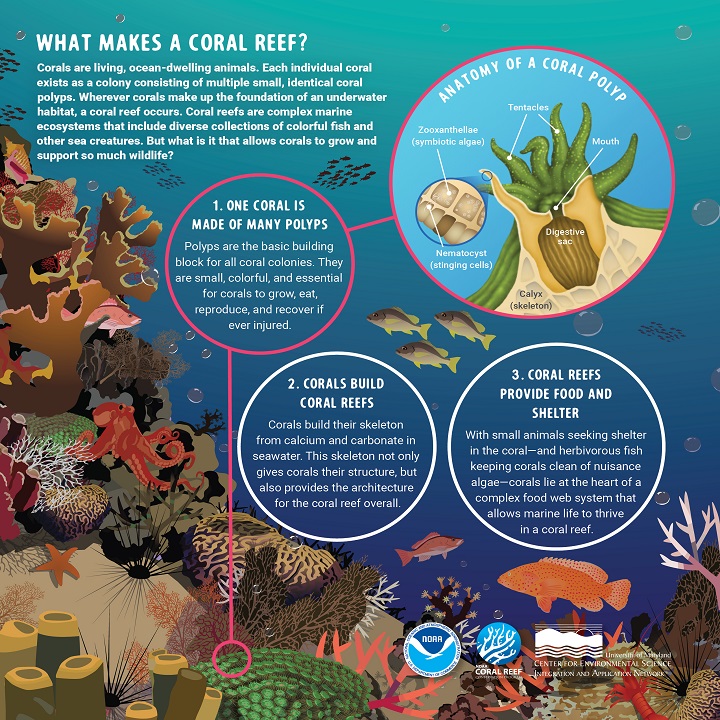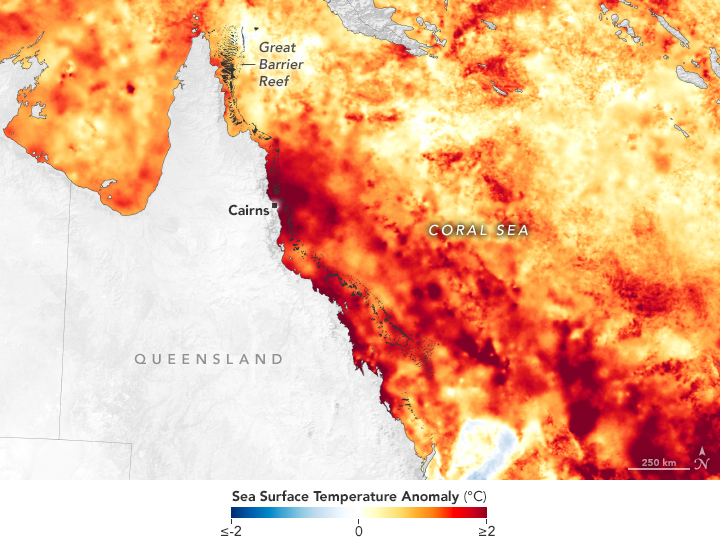Ask NASA Climate | June 22, 2023, 10:44 PDT
Vanishing Corals, Part One: NASA Data Helps Track Coral Reefs

A healthy coral reef. Credit: Jeremy Cohen, Penn State University
Coral reefs, nicknamed the rainforests of the sea, are colorful, majestic underwater worlds teeming with life. However, their future is in jeopardy due to climate change, water pollution, and other human activities. Let’s explore why corals are important to us, how they are changing, and NASA’s role in monitoring their health.
Coral reefs are one of the most important ecosystems on the planet. While they cover less than 1% of the ocean floor, healthy coral reefs provide homes to approximately a quarter of all known marine species. Currently, scientists have identified almost 800 species of reef-building corals around the world.

Coral reefs also help protect human life and property. First, they act as a natural barrier for coastlines by dampening rough waves during storms. Second, they are the source of several cutting-edge medicines. And third, they generate billions of dollars for local economies through ecotourism and fisheries, while also serving as a critical food source in many island nations.
However, coral reefs are disappearing worldwide. We know this through extensive surveys conducted every decade. “Since 2009, the United Nations-supported Global Coral Reef Monitoring Network found that 14% of the corals have disappeared, and things are speeding up,” stated Dr. Ove Hoegh-Guldberg, professor of marine studies at the University of Queensland in Australia.
A special report in 2018 from the Intergovernmental Panel on Climate Change (IPCC) projected that coral reefs would decline by 70-90% if average global air temperatures warm by 1.5°C (2.7°F) above pre-industrial values. That number jumps to a 99% decline at 2°C (3.6°F) of warming. With the planet already warming approximately 1.1°C (2.0°F) due to human activities since the end of the 19th century, these declines in corals could be reached by 2050 or sooner.
It’s not feasible for scientists to monitor the state of every coral reef each year. While divers can provide detailed information about the health of individual corals, the work is labor- and time-intensive, often taking weeks to survey one reef. That’s where airborne and satellite data from NASA and other agencies play a vital role.

According to Juan Torres-Pérez, research scientist with NASA’s Ames Research Center and a representative on the U.S. Coral Reef Task Force (USCRTF), several NASA satellites have proven very useful in monitoring sea surface temperature and water quality changes over time, both of which are associated with changes in coral reef health. “NASA’s publicly available data provides scientists with valuable information to identify these changes as they happen,” he said.
“To study a global problem, like the decline of coral reefs, you have to have a global perspective,” added Ved Chirayath, professor of Earth sciences at the University of Miami. Using NASA satellites and other remote sensing instruments, scientists can monitor coral reefs and their surroundings more frequently and more widely to help determine if they are changing. “Some challenging places to survey in the water are some of the most important to measure," he added, "as that’s where the changes are happening.”
One region that has been particularly challenging to measure from above is the tropics. According to Liane Guild, a scientist with NASA Ames and the USCRTF, prevalent cloud cover in the tropics can hinder the measurement of tropical regions from aircraft and satellites. “Innovative field tools, like using drones with cameras, can help acquire images below clouds, if present,” she said. “They can also collect fine-detailed images locally on corals to help understand coral health condition and decline.”
Once the causes of coral reef changes can be measured, tracked, and predicted, scientists can take action to protect them.
So how does climate change lead to a global decline in coral reefs, and is there hope for their future? Check out Vanishing Corals, Part Two to find out.
